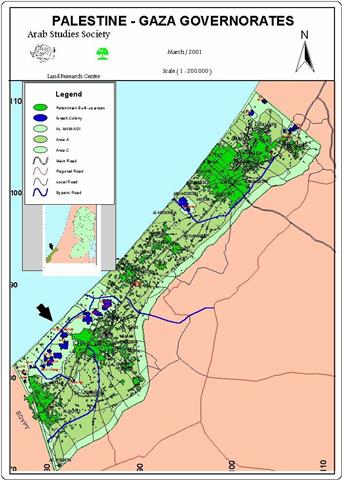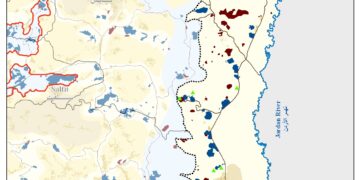Prelude:
The name ''Al Mawasi'' refers to the agriculturally fertile strip of land laying parallel to the Mediterranean Sea in Gaza. The 16-kilometer-long strip starts in the city of Rafah and extends throughout Khan Yunis until it reaches the city of Deir Al Balah in the north. The Oslo Agreements have classified Al Mawasi to be ''yellow areas'' where Israeli is responsible for the security issues while the Palestinian Authority is responsible for the civil matters of the 5000 residents of the region, most of which work in the fishing and agriculture sectors. See Map
The region suffers from a general lack of basic infrastructure as a result of over thirty years of Israeli occupation and neglect. The signs of such neglect are evident by the absence of health and educational facilities other than Jarar Al Qidwa School, which was opened in 1998 in Mawasi Khan Yunis under the auspices of the Palestinian Authority, in addition to the absence of health services expect for a small hospital in Mawasi Rafah. Furthermore, the region is plagued with a general lack of communication, sewage, electrical, and water networks as residents depend on digging for underground water for their daily water intake.
The Israeli policy in Al Mawasi:
In order to implement its long-planned policy of evicting Al Mawasi of its Palestinian residents, Israeli authorities have prohibited any type of renovation or development of any existing building in Al Mawasi in addition to disallowing the building of new house and/or infrastructure on any land less than 25 dunums in size. This condition has restricted any kind of development given that most of the land owned in Al Mawasi is less than 25 dunums per owner.
Moreover, the Israeli authorities have insisted during the Oslo negotiations to keep huge tracks of Palestinian lands under its jurisdiction especially land around the Israeli settlements in the Occupied Territories. Giving these lands the term ''yellow area'', Israeli authorities prevented any development of these lands as a prelude to its confiscation and using it for future settlement expansions. As mentioned earlier, Al Mawasi became a ''yellow area'' according to the Oslo Accords leaving it an easy prey for Israeli authorities to expel its residents and to use it to guarantee the geographical continuation between the Gush Qatif colonial block and the sea, a goal Israel has strifed to achieve for a long while.
In order to attain this goal, Israeli occupation forces have increased the frequency of its attacks on Al Mawasi residents since the eruption of Intifadat Al Aqsa on the 28th of September 2000. This report focuses on this policy in terms of its two axis; the complete blockade and prevention of resident's movement in addition to land bulldozing tree uprooting, and the destruction of property.
A) Siege and Road Blockade:
Al Mawasi region is surrounded by the sea from the west, Egypt from the south, in addition to Israeli settlements from the east and the north. The residents of this region are not permitted to enter the region expect through using three roads as specified by the Oslo Agreements. These roads are:
-
The road leading to the city of Rafah through Tal Al Sulatan checkpoint.
-
The road leading to Khan Younis through Al Tuffah checkpoint
-
The road leading north to Deir Al Balah to the checkpoint located at the beach.
Stories are abundant about the mistreatment and humiliation Palestinians face at these checkpoints, not to mention the practice of taking the residents' ID s for no apparent reason and making them stand for hours before giving it back to them.
Such practices were intensified after the eruption of Intifadat Al Aqsa as Israeli soldiers prevented any type of vehicles from entering or leaving the region. Such prevention included even ambulances carrying the sick or the dead. The flow of food and essential agricultural materials was also hindered and halted for extended periods of time while the movement of individual Palestinians was seriously obstructed as Israeli forces blocked all main and secondary roads leading into and out of the region with cement blocks and sandy hills. For example, occupation forces bulldozed on the 16th of January 2001 the main road connecting between Al Mawasi and Deir Al Balah in addition to erecting a sandy hill all along the northern border of the region causing its isolation and separation from the nearby Deir Al Balah.
In addition to the outer siege of the region, Israeli forces and settlers impose an internal siege as they prevented the movement of the Palestinian residents outside of their population centers preventing them, in the process, from reaching their nearby farms. A case-in-point took place between the 15th and 22nd of January, 2001, as Israeli forces blocked the inner-roads of the region by cement blocks and erecting sandy hills to prevent the movement of the residents and to isolate the population centers from each other. These forces also introduced a number of mobile checkpoints in a number of locations inside Al Mawasi as to reinforce the siege and to reduce the movement of the residents to a minimum.
B) Land Bulldozing, Tree Uprooting, and the Destruction of Property:
Israeli avidity for the lands of Al Mawasi did not cease as a result of the signing of the Oslo Agreements as we have witnessed throughout the years a number of attempts to bulldoze as many dunums of land as possible by the Israeli authorities. Such attempts continued unabated during Intifadat Al Aqsa as the Israeli Army joined forces with the Israeli settlers to attack the agricultural lands and to prevent its owners from accessing it. Case-in-point took place on the 15th of January 2001, when tens of settlers, protected by the Israeli Army, attacked the residents of Al Mawasi region and their possessions. Eyewitnesses asserted that tens of settlers fired shots on residential houses, burnt a number of homes, cars, storage bins, tractors, in addition to a number Green Houses. Furthermore, they have bulldozed agricultural lands in addition to uprooting trees and blocking water wells. Such actions did not subside until the 22nd of January 2001, though some similar activities took place afterwards between now and then. The total loss can only be estimated at the razing of 270 dunums, the destruction of 15 Green Houses, the spoilage of the strawberry season, the obliteration of a number of water wells, in addition to the uprooting of thousands of Guava, palm, and citrus trees.
The general suffering endured by Al Mawasi residents can be summarized in the following points:
-
The prevention of the entrance of medical equipment and foods to the region.
-
The difficulty of transporting the sick and the elderly to hospitals outside of the region to receive the appropriate treatment.
-
The prevention of ambulances from entering the region.
-
The banning of farmers from reaching an/or farming their land.
-
The spoilage of crops and fruits as a result of farmer's inability to transport them to the markets.
-
The prohibition imposed upon workers not to reach their work places.
-
The obstacles faced by the students and teachers of Al Mawasi that prevents them from reaching their schools and university.
-
The prevention of fishermen from going into sea to catch fish. It is usually their only source of daily income.
-
The bulldozing of dunums upon dunums of agricultural lands.
-
The destruction of green houses, wells, water distribution systems, and water ponds.
-
The destruction of tractors, cars, agricultural equipment, storage bins, and residential houses caused by the settlers.
-
The prevention of Palestinian fire fighters from reaching the location of the fires inside Al Mawasi to put out fires set by Israeli colonist.
Annexes:
Name of Eyewitness: Mr. Sha'aban Ridwan Abdel Al A'al Al Aba'adleh
Resident of: Al Qarara village, Gaza.
Age: 41
Marital Status: Married with 7 children.
Profession: Farmer
ID No.: 93431596
Mr. Sha'aban gave the following statement under oath:' I was attending to my land located in Mawasi Khan Yunis on the morning of Saturday the 13th of January 2001 when a large Israeli force accompanied with a bulldozer arrived at the location. The force started bulldozing parts of my land, destroying in the process a storage bin in addition to a water well. The force also bulldozed parts of land owned by my relatives. Such activities took place over a period of four days, resulting in the bulldozing of all of my land (34 dunums), the uprooting of more than 800 Guava trees, 350 palm trees, 100 mango trees, 70 olive trees, in addition to 50 pomegranate trees. In terms of agricultural equipment, the bulldozing wiped out the watering system in my land in addition to 500 meters of plastic, 2 water wells, 2 water-pumping engines, a storage bin that contained three tons of chemical fertilizers, 2000 liters of fuel, an engine specially used for spraying chemical fertilizers, and finally it caused the spoilage of 7 tons of natural fertilizer. It is worth mentioning that my brothers and I own this piece of land. It is the only source on income for our families, 35 members in all'.
Name of Eyewitness: Mr. Iyad Mohammad Abdel Hameed Al Aba'adleh
Resident of: Al Qarara village, Al Mawasi, Gaza.
Age: 43
Marital Status: Married with 6 children.
Profession: Farmer.
ID No.: 930207105
Mr. Iyad gave the following statement under oath: 'While attending to my land on Sunday the 7th of January 2001, I saw 4 Israeli bulldozers approaching my land accompanied with a large Israeli force and a number of tanks. When the bulldozers started razing my land I screamed at the soldiers and started, with the help of my family, removing as much equipment as possible to prevent its destruction. While doing so, the Israeli tanks opened fire at us and prevented us from removing anything from my 12-dunum piece of land'. The razing activity caused the following damage:
-
The total destruction of a water well and the water pump associated with it.
-
The total ruining of the irrigation network.
-
The demolishing of a small agricultural hut used for overnight stays whenever needed.
-
The destruction of a storage bin that contained 2 pumping motors in addition to agricultural equipment, fertilizers, and agricultural pesticides.
-
The uprooting of 100 mango trees, 200 palm trees, 600 Guava trees, in addition to 100 lemon trees.
Now that the land has been totally razed we are prevented from approaching it due to the fact that Israeli soldiers open fire at us once we come near the land.
Name of Eyewitness: Mr. Hamad Marzooq Mahmoud Al Sha'er
Resident of: Mawasi Khan Yunis, Gaza.
Age: 42
Marital Status: Married with 6 children.
Profession: Farmer
ID No.: 938762861
Mr. Hamad gave the following statement under oath:' It was almost ten o'clock in the morning of Monday the 15th of January 2001 when I heard some loud noises outside of my house in Mawasi Khan Yunis. I then saw more than 200 Israeli settlers accompanied with some TV crewmen. The settlers started throwing stones and shooting live ammunitions at the houses. I also saw these settlers destroying whatever they can of residents' possessions before setting a blaze the irrigation system of my land. They have also set fire to my 1.5-dunum Green House in addition to destroying the onion harvest in the other 2.5 dunums that I own. My Guava and citrus trees were not spared the blazing and destruction, either. After this incident, I was forbidden from entering my 10-dunum piece of land which I planted with Guava and citrus trees. The harvest of this land was spoiled because we could not collect it on time. As of this time, I am forbidden from entering my land because every time I try to do just that I'm faced with flying bullets fired at me by the Israeli settlers'.
Prepared by
The Land Research Center
LRC














